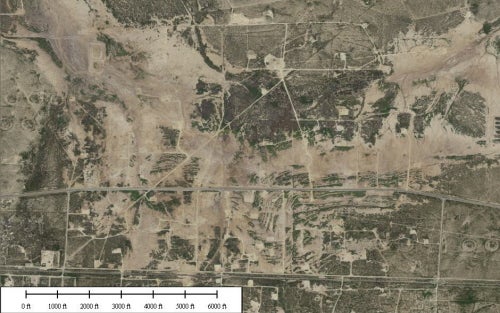
The “Texon Scar”
A massive release of produced water from an oil well in West Texas caused a vegetative dead zone that can be seen from space.
Oil and gas development produces massive amounts of air and water pollution that can have severe impacts on our communities and ecosystems. And data in a recent investigative article could help us understand more about where and how much oil, wastewater, and other fluid are spilled across the country.
According to an EnergyWire article by Pamela King and Mike Soraghan, in 2015 industry reported more than 10,000 cases of spills across the country. That amounts to 42 million gallons of harmful fluids – 12 million gallons more than previously reported.
Spills can occur for a variety of reasons, like leaky infrastructure and sloppy operations. And their impacts can be devastating – particularly when it comes to spills of produced water. Chemicals in this wastewater can severely contaminate water resources, while the high salt content can wreak havoc on local ecosystems. For example, wastewater releases in the 1920s that spread across thousands of acres in West Texas created a vegetation dead zone visible from space. Almost 100 years later, state officials are still working to restore the area.
In a 2015 draft assessment, the Environmental Protection Agency acknowledged the threat of these spills, although the details of the full analysis were undercut by the report’s broader finding that hydraulic fracturing activities were not found to have “widespread, systemic” impacts on drinking water. But the thousands of recorded spills tell another story.
For this, and other reasons, EDF is among the growing chorus of voices, including the agency’s own Science Advisory Board, calling on EPA to clarify this conclusion. Oftentimes national statistics don’t reflect the severity of local problems, and by stating that spills were not “widespread” or “systemic” the EPA spurred misleading headlines about the overall “safety” of oil and gas development. It created confusion that ultimately gave industry an excuse to run business as usual, despite the existence of these well-documented impacts.
Case-in-point, in the EnergyWire article, a spokesperson with an industry lobbying group said the data reinforces the idea that current efforts to manage oil and gas spills are effective. But 10,000 spills clearly indicate something isn’t working.
We can do better.
Spills are not a new problem. They have been a constant issue for this industry for over a century. And while there has been growth in the development of spill-prevention technologies and practices, we should be capable of substantially reducing spills to much lower levels.
We need policies that standardize leading practices and encourage additional advancements to ensure that the pits, tanks, trucks, and pipelines that hold and transport oil, gas, and wastewater are properly constructed, maintained and operated. And we need better monitoring, reporting and remediation requirements so that when accidents do happen, we can address them more quickly and efficiently.
EDF is pushing for preventative regulations in oil and gas regions. Some states – and industry players – have made headway toward reducing spill rates and minimizing spill impacts. But as this most recent data indicates, there is room for improvement.
Oil and gas spills may not happen all the time and the may not happen everywhere. But even if spills are not a “widespread, systemic” problem – these and other local impacts matter to the affected communities. EPA and the industry must acknowledge that these impacts are real, so we can make greater progress on minimizing risks to our health and our environment.
Photo source: American Geophysical Union
Enviroshop is maintained by dedicated NetSys Interactive Inc. owners & employees who generously contribute their time to maintenance & editing, web design, custom programming, & website hosting for Enviroshop.
